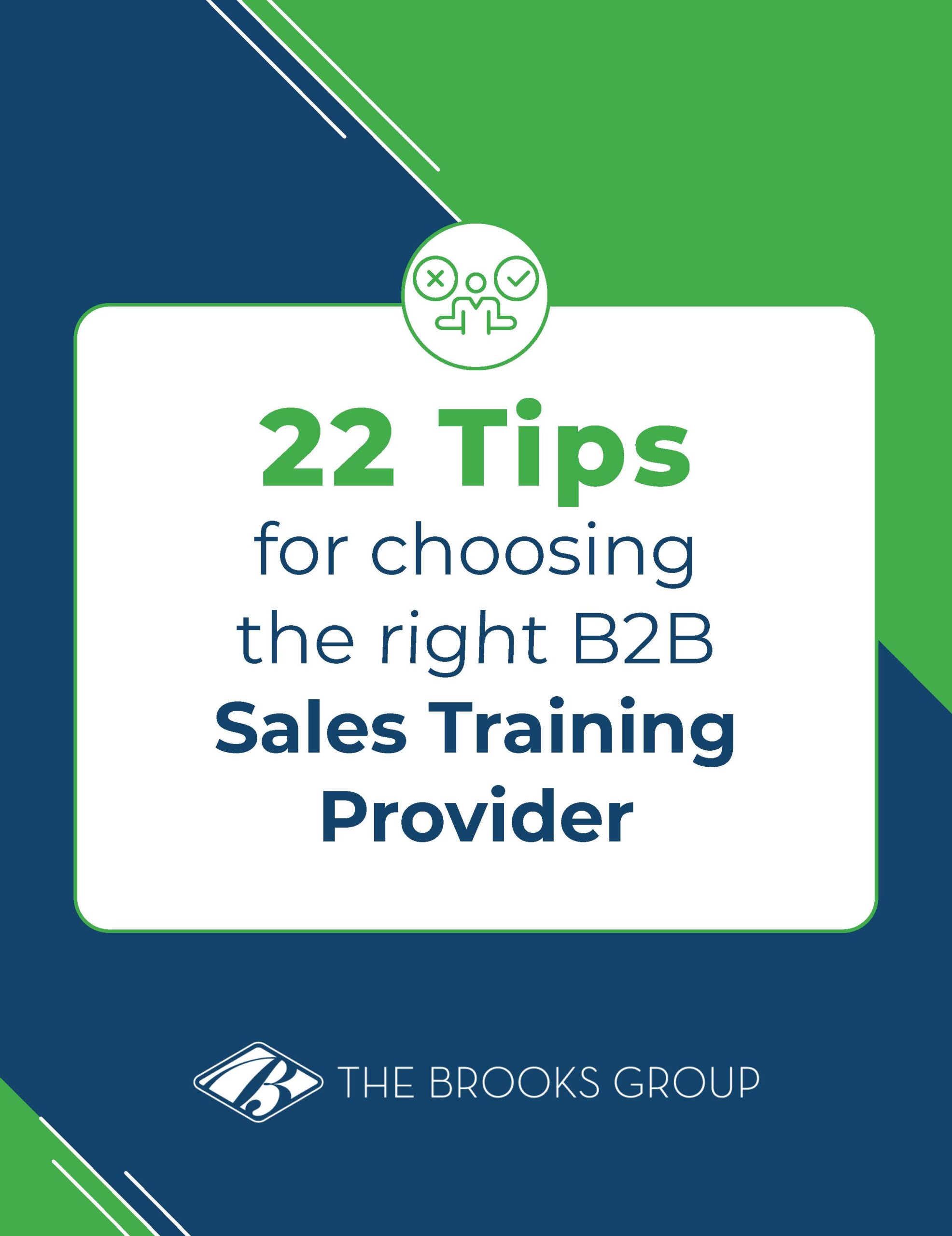The best sales training unlocks the full potential of your sales team. Effective training equips your sales professionals with selling skills and strategies to engage buyers, build trust, and increase win rates.
But planning a B2B sales team training program can be daunting if you haven’t done it before—and there are a number of potential pitfalls. This post walks through 14 steps you can follow to plan and launch a successful initiative.
Deliver Sales Skills, Strategies, and Process to Drive Revenue
Sales training is one of the most important steps you can take to grow top-line revenue. Improving your sales team’s selling skills to help them close more deals is the goal of any sales training initiative.
A successful sales training initiative—from initial discovery work to design to delivery to reinforcement—will have a measurable, long-term impact on your entire sales team.
Training that doesn’t engage your sellers or that teaches a complex sales process virtually guarantees your team won’t use what they’ve learned in their daily activities. Content that doesn’t address your sellers’ specific areas of strength and development areas will miss the mark.
You need to deliver team-specific training on a straightforward sales process your sales team will want to use every day. Here’s how to make it happen.
14 Steps to Planning a B2B Sales Training Course
1. Choose trainers and/or a training provider
Decide whether to use internal trainers, external providers, or a combination of both based on your needs and resources. Evaluate potential trainers or partners based on their expertise, experience, and track record of success. Ensure chosen trainers align well with your company’s culture and values to maximize effectiveness. (See the following section to learn the benefits of working with a sales training company).
2. Assess Current Sales Performance and Identify Gaps
Begin by analyzing your sales data and key performance indicators (KPIs) to understand where your team stands. Conduct surveys or interviews with both sales team members and managers to gather insights on perceived challenges and areas for improvement. Review customer feedback to identify any recurring issues in the sales process. Use sales assessments to pinpoint specific areas where performance falls short of expectations or industry standards.
3. Define Clear Objectives and Desired Outcomes
Set SMART goals (Specific, Measurable, Achievable, Relevant, Time-bound) for your training initiative to ensure focus and measurability. Align these objectives with your overall business strategy to ensure the training supports broader company goals. Clearly define what success looks like for the training program, including both quantitative metrics and qualitative improvements you hope to see.
4. Determine Participants
Identify which sales roles will be included in the training, such as sales development representatives, account executives, or managers. Consider the experience levels and existing skill sets of your team members to ensure the training is appropriately targeted. Assess whether to include supporting roles like sales operations or customer service teams, as their involvement may enhance overall sales performance.
5. Choose Sales Training Topics and Content
Based on skills gaps and objectives, select specific topics to address in your training. These may include product knowledge, sales techniques, soft skills, or industry-specific content. Ensure all chosen topics are relevant to your particular industry and align with your company’s sales process and methodologies.
6. Select Appropriate Training Methods and Formats
Consider various sales training delivery options such as in-person workshops, eLearning modules, role-playing exercises, or on-the-job training. Identify the venue and location for training. Evaluate the benefits of a blended learning approach, which combines multiple methods for enhanced effectiveness. Take into account your team’s preferences and learning styles to maximize engagement and retention.
7. Develop or Acquire Training Materials
Create or purchase the necessary training materials, which may include slide decks, workbooks, videos, or interactive digital content. Ensure all materials are engaging, interactive, and aligned with your company’s branding and messaging. Consider developing materials that can be easily updated and reused for future training sessions.
8. Set Timeline and Schedule
Determine the duration and frequency of training sessions, taking into account the scope of content and your team’s availability. Consider the potential impact on ongoing sales activities and quota attainment when scheduling training. Plan for pre-work, main training sessions, and follow-up activities to reinforce learning over time.
9. Allocate Budget and Resources
Calculate all costs associated with the training, including materials, trainers, venues, technology, and any travel expenses. Consider the opportunity cost of time away from selling activities. Secure necessary approvals and funding from leadership, demonstrating the expected return on investment for the training initiative.
10. Create a Communication Plan
Develop clear and compelling messaging to announce and promote the training initiative to your team. Set clear expectations for participation, commitment, and desired outcomes. Address any potential concerns or resistance proactively, emphasizing the benefits of the training for individual and team success.
11. Implement the Sales Training Program
Execute the training according to your established plan, ensuring all logistics are smoothly handled. Monitor attendance and engagement levels throughout the training process. Be prepared to make real-time adjustments if certain aspects of the training are not resonating with participants or if unexpected challenges arise.
12. Measure Results and Gather Feedback
Collect data on the defined metrics and KPIs to assess the impact of the training. Conduct post-training surveys or interviews to gather qualitative feedback from participants. Compare performance data from before and after the training to quantify improvements and identify areas that may need further attention.
13. Follow Up and Reinforce Learning
Provide additional resources or job aids to help participants apply their new skills on the job. Implement sales coaching or mentoring programs to support ongoing skill development. Recognize and reward team members who successfully apply their new knowledge and skills in their daily work.
14. Evaluate and Iterate for Continuous Improvement
Analyze the overall effectiveness of the program, considering both quantitative results and qualitative feedback. Identify areas where the training could be refined or expanded for even greater impact. Plan for ongoing or refresher training sessions to ensure skills remain sharp and to address any new challenges that arise over time.
Benefits of Choosing a Sales Training Provider
You could follow the steps above to develop and deliver training in-house. But working with a dedicated sales training provider offers several benefits compared to internal resources.
- Expertise: Professional training organizations bring specialized knowledge and experience.
- Fresh perspective: External trainers can offer new insights and challenge existing assumptions.
- Time savings: Outsourcing training frees up internal resources for other priorities.
- Proven methodologies: Training providers use the most up-to-date techniques and recognized processes.
- Customization: Many companies tailor programs to your specific needs and industry.
- Objectivity: External trainers can provide unbiased assessments and feedback.
- Consistency: Professional partners ensure uniform quality across training sessions.
- Scalability: Training companies can often accommodate larger groups or multiple locations.
- Cost-effectiveness: In many cases, outsourcing can be more economical than developing in-house programs.
- Continuous improvement: Training providers regularly update their content based on industry trends and provide sales training reinforcement.
Planning Your B2B Sales Training Program
Planning a sales training initiative (and choosing the right sales training provider for your organization) depends on your industry dynamics, management objectives, organizational culture, and sales team capabilities. If you’re investing in sales training, give your project the best chance of success by considering every factor to give your team the edge.
Sales Training with The Brooks Group
Discover how IMPACT Selling® sales training program empowers sales professionals and teams with confidence and skills to generate breakthrough results.
White Paper Download
22 Tips for Choosing the Right B2B Sales Training Provider
Choosing a sales training provider is one of the most important business decisions you’ll ever make. But with so many confusing choices, finding the right partner can be overwhelming. Download this white paper for 22 tips to help remove the uncertainty and give you greater confidence in your decision.





